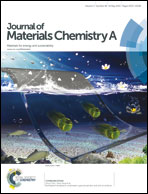Subunits controlled synthesis of α-Fe2O3 multi-shelled core–shell microspheres and their effects on lithium/sodium ion battery performances†
Abstract
Two kinds of Fe2O3 core–shell microspheres were synthesized. The Fe2O3 sample obtained using ethanol (E–Fe2O3) contains a shell and a core assembled by nanoparticles with a diameter of ∼150 nm and the surface is fairly smooth. Fe2O3 with optimized subunits was produced using water (W–Fe2O3). The core is assembled by smaller nanoparticles of ∼50 nm. The thicker shell and exterior surface possess porous nanorods. These peculiar subunits endow W–Fe2O3 with a higher specific surface area, more pore volume and larger nanopores. W–Fe2O3 displayed 733.1 mA h g−1 at 6000 mA g−1, which is more than two times that of E–Fe2O3 (306.5 mA h g−1). Encouragingly, W–Fe2O3 also expressed relatively promising sodium ion battery performances. The significantly different performances between E–Fe2O3 and W–Fe2O3 can be almost entirely attributed to their distinctive subunits. The study demonstrated that enhanced lithium/sodium ion storage properties can be achieved by adjusting the subunits.


 Please wait while we load your content...
Please wait while we load your content...